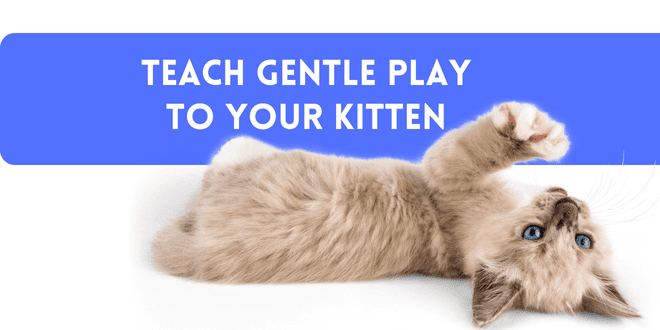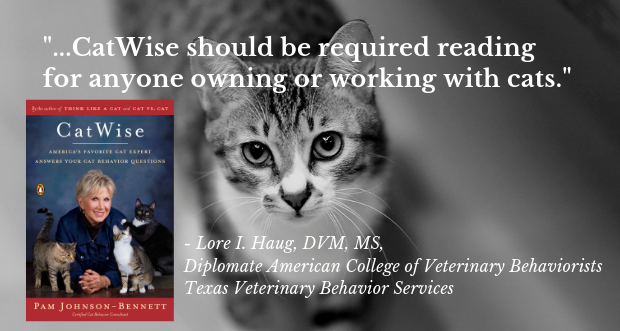
Early Learning
When kittens are with their littermates they learn how to engage in social play. This is the time when each kitten learns how to use an inhibited bite so as not to cause injury. A kitten who bites too hard is either reprimanded by the queen or gets a very negative reaction from a littermate. This social play is important and each kitten soon learns the rules. Facial expressions and body postures displayed during play also indicate that the session is friendly and not truly aggressive.
When kittens reach about 12 weeks of age, social play may have a tendency to become a bit too aggressive so if you have littermates who are still together, you’ll have to pay closer attention so you can monitor their interaction. Make sure they have lots of opportunities for solo play and other ways to work off that kitten energy.
If you are adopting a kitten and he is now leaving littermates, it will be up to you to help teach the correct manners when engaged in playtime with you.
Playtime is Important
When kittens play it’s not just about having fun. Playtime is teaching them important skills they’ll need as adults. All the chasing, climbing, pouncing, and seemingly endless energetic bursts help kittens learn about their emerging skills and helps them develop balance, stealth, coordination, and all the other skills they’ll need to be successful hunters.
The playtime your kitten does with you, when done correctly, will help develop the emotional bond and teach how to play without crossing over into biting or scratching you. It’s up to you to gently guide your kitten.
Appropriate Toys for Kittens
The first and most important rule when it comes to teaching a kitten to play gently is to not use your fingers as toys. No matter how young your kitten is and whether it hurts when he bites or not, this isn’t the message you want to send. Biting flesh is never to be allowed. It’s also unfair if you use your fingers to entice your kitten to play and then get angry when he reacts by biting or scratching your hand. Don’t send mixed messages. Never poke, wiggle your fingers, or wrestle your kitten. It may not hurt so much now, but if you train your kitten that hands are toys, it will hurt when he becomes an adult.
From the very beginning, have appropriate toys for your kitten to bite during play. For interactive playtime, use toys based on a fishing pole design. That will put a safe distance between your hands and your kitten’s teeth. This way, when your kitten is enthusiastically involved in play he won’t have to worry about crossing the line. The interactive toy, by providing a distance between the kitten’s teeth/claws and your body, lets him freely use all of his weapons. Biting is an especially important part of hunting. Playtime for cats mimics the way they hunt so your kitten needs that opportunity to use teeth and claws.
The fishing pole type interactive toy also increases the fun factor because you can move the toy like prey so your kitten can get fully immersed in the game. If you move the toy across or away from his visual field you’ll trigger the prey drive instinct and you’ll see your kitten’s interest level greatly increase. All of this fun can then happen while keeping you at a safe distance.
If you do use smaller toys such as fuzzy mice, be sure you toss them for the kitten to chase. Don’t dangle them where your fingers could get bitten or where your kitty could reach up and you. During playtime you never want to send a mixed message.
Maintain Your Kitten’s Interest
With a kitten, you may find they lose interest if you bring out the same toy repeatedly. Have a variety of toys so kitty will never know what surprise you have in store for at the beginning of every play session. It also teaches your kitten to use different skills, depending on what type of prey the toy mimics.
When Your Kitten Bites You
When your kitten bites you, immediately stop all action and stay still. If they’re biting your ankles, stop moving. I know this seems like the opposite of what you feel you should do but kitty wants movement so if you stay still, he won’t be getting the desired result. If the kitten bites your hand, stay still. Instead of pulling away, just freeze. If it’s your ankle they have grabbed onto, stop all movement. This will confuse your kitten and he’ll loosen his grip. If you pull away, you are acting like prey and the kitten’s instinct will say to bite harder. If you freeze you are in no way acting like prey would.
Ignore your kitten for a few seconds. This will send the message (if you’re consistent in your training) that biting skin will mean the game stops. Reset the game by redirecting your kitten to the toy. If he bites you again, repeat the sequence so he’ll eventually learn that biting the right object continues the fun game but biting the wrong object stops the fun.
What Not to Do When Your Kitten Chomps Down
If your kitten bites, don’t hit, push him away, squirt with water, or yell. Although these actions may momentarily cause your kitten to release his grip, they can have long-term negative effects. Your kitten may soon learn to become afraid of you. If you do any type of physical reprimand then you can also send him into a defensive state and this could actually cause him to bite harder the next time or become more aggressive. The last thing you want with your new kitten is for him to become afraid and eventually start avoiding any interaction with you.
Ending Playtime
When you decide playtime is over, you don’t want to leave your kitten in a revved up state. It’s not only frustrating for your kitten to have play end abruptly, but it can also increase the risk that he may redirect all that energy toward whatever is moving — your hands or feet. It’s also just not satisfying for a hunter to suddenly have the prey disappear. You want to end playtime in a way that creates confidence and also leaves your kitten satisfied. To do this, wind the action down as you end the game, as if the prey is wounded and about to die. This will help your kitten feel as if he engaged in a successful hunt. Offer a treat for a job well done. You can also time play sessions to take place before mealtime so it will truly mimic the reward of the hunt.
Put interactive toys away after playtime to prevent your kitten getting tangled up in the strings and to avoid the risk of strangulation. You also want to keep the interactive toys as something special — something directly connected with you. Any toys you leave out for solo play should only be safe ones specifically intended for unsupervised play.
Petting Mode or Play Mode?
To avoid bites in general, it’s important to read your kitten’s mood. You may want to pet but kitty may be in play mode. If he’s a ball of energy right now, then this isn’t the time for petting. Pay attention to what your kitten needs at the moment. Pet when your kitten is quiet, and play when he’s energetic. If you’re dealing with a kitten who has a tendency to bite after being petted because he gets too excited, watch body language so you know when to stop. If you can’t engage in an interactive play session at that moment, have a little toy nearby to toss (toss it away from you) for some solo playtime if you notice your kitten is getting revved up. You can add a verbal reminder such as “go get the toy“ or “go fetch” for a little added training.
Educate Family Members
For training to be effective, everyone in the family needs to use the same technique. Make sure family members know the correct playtime method, how to avoid getting bitten and how to react if the kitten does accidentally bite.
Be Consistent with Playtime Schedule
Kittens have lots and lots of energy. In addition to all the solo playtime opportunities, be consistent in doing interactive playtime several times a day. It’s not just about fun; these sessions provide valuable lessons that will pay off when the kitten matures. Even as an adult, he needs those interactive play sessions on a regular basis. As an adult, schedule at least two sessions per day, lasting about 15 minutes each. As a kitten though, several short sessions are needed. You don’t want to exhaust your kitten — you want to provide a consistent, healthy energy outlet.
Need More Information?
For more specific tips on playtime with your kitten and step-by-step kitten training techniques, refer to Pam’s best-selling books. Pam’s books are available at bookstores and online. We’ve included links to Amazon here on our website.
If you have a question regarding your cat’s health, please contact your veterinarian. This article is not intended as a replacement for your cat’s veterinary care.




